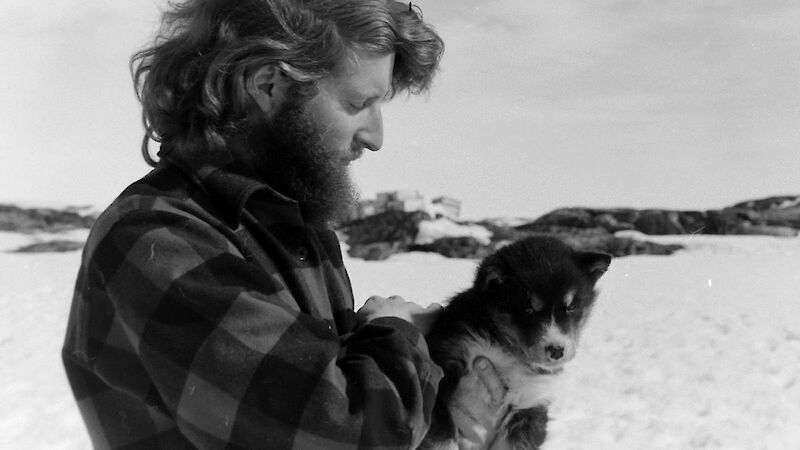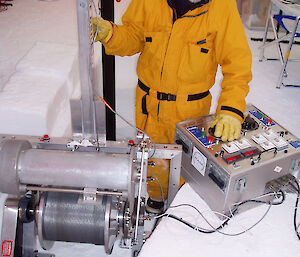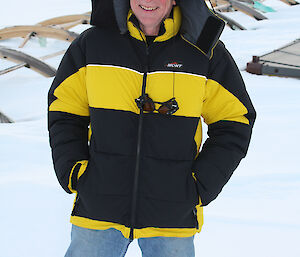One of our longer-serving scientists, recently retired glaciologist, Vin Morgan, celebrated 40 years with the Australian Antarctic Division late last year. This is his story.
My association with the Australian Antarctic Division began in 1967 when I was finishing my physics degree, and the need to get some sort of job was looming. A job at the Antarctic Division that involved experimental work in physics, in an interesting place, looked a lot more fun than sitting in an office. I duly applied and after a chat with Science Director, Phil Sulzberger, mainly about where the program was going, I was signed up.
In 1967 the Antarctic Division was crammed into an office block in St Kilda Road, Melbourne. The expeditioner physicists all worked in one long room. There were two generations; returned expeditioners who had wintered at Wilkes the previous year, and new expeditioners who were to winter the following year. Although the chatter probably didn’t do much for scientific output it was extremely useful for the new expeditioners. After eight months I felt I knew a lot about Wilkes station and living in Antarctica.
Telex messages from the 1967 winterers indicated that the upper atmosphere physics equipment wasn’t running very well. So the electronics engineer, Bruce Morton, and I, organised and constructed equipment to replace most of it, and tested it at the Division’s field station at Eltham, near Melbourne.
I sailed from Melbourne on Thala Dan and we arrived at Wilkes on January 22, 1968. In those days, changeover was a frenetic time during which the new expeditioners had to unload all the stores and equipment and learn how to run the station in just a few days. But in 1968 changeover was extended to allow some new buildings to be assembled at 'Repstat' – the replacement station for Wilkes, which became Casey in 1969 (Australian Antarctic Magazine 15: 24–26, 2008).During changeover Bruce and I moved all the old equipment out of ‘Cosray', as the upper atmosphere physics and cosmic rays hut was called, and installed our new gear. It worked well and a reasonable amount of data was collected during the year.
Apart from the physics work I did a couple of (short) dog trips and a vehicle trip in to near ‘S2’ on Law Dome. I did printing and editing for the ‘newsletter’ Drift 68. I was also ‘court marshaled’ for being the ‘phantom poet’ — which was pretty funny because I actually wasn’t the phantom poet (although I did like his work).
In 1969 Bill Budd, head of glaciology at the Antarctic Division, wanted a physicist to set up a system to carry out oxygen isotope analysis, to investigate the Amery Ice Shelf ice core that was drilled in 1968. I was in the right place at the right time, and I moved from upper atmospheric physics to the glaciology program, where I've remained ever since.
I spent my first year as a glaciologist at CSIRO Chemical Physics, rebuilding a mass-spectrometer for the isotope analysis. It was actually the first mass-spectrometer in Australia and amongst the rather quaint (even for 1970) circuit diagrams and drawings were letters from the Australian and US governments negotiating security arrangements for the importation of the machine. Mass spectrometers separate isotopes and just after the Second World War these types of machines were proposed for producing enriched uranium.
Once I got it working again we got some nice results that showed ocean water was freezing onto the base of the Amery Ice Shelf. Initially, the isotope measurements on the Amery and Law Dome cores were used as tracers of ice flow, to provide data for the computer modeling of the ice sheet being conducted at the University of Melbourne.
Around 1970 a series of landmark papers showed how ice core isotope ratio data could be used as a proxy for climatic temperature. So I started interpreting the core profiles as climate records. In 1970, ice core climate records were a pleasantly obscure line of research. Now, climate change is a hot topic of conversation, and ice core records have appeared in popular films and on ABC TV. Today the glaciology section has an ice core/climate history group, who are still measuring isotopes in ice cores. In 2007 they purchased their third mass spectrometer.The biggest challenge of my career was the deep ice core drilled at ‘DSS’ near Law Dome Summit between 1989 and 1993. Law Dome is a small ice sheet attached to the edge of the main East Antarctic ice sheet, and with an independent ice flow. It exists because its bedrock is an island separated from the bedrock of East Antarctica by a deep trench. Law Dome is the backyard of Wilkes and Casey stations so its glaciology has been studied since the International Geophysical Year in 1958.
Previous ice drilling on Law Dome had reached depths of about 400m, but in the late 1980s we decided to try to drill a full depth, 1200m core at the summit, to get a long, high resolution coastal climate record. I was the principal investigator for the project, which involved a lot of logistics and new technology that seemed to require a huge amount of organisation. In the end, however, with a lot of support from the Antarctic Division’s instrument workshop (for the drill) and engineering group (for field and station logistics), the base of the ice sheet was reached after several summer seasons work, in February 1993. The core produced a climate record extending back 90 000 years and the glaciology team is still analysing it.
I have observed some significant changes during my time in Antarctica, including enormous improvements in communications. In 1968 there were no phones and no internet; just telex messages, HF radio telephone (which was usually unintelligible) and a bit of amateur radio. The stations were more isolated; if there was a solar proton event it could black out HF radio and there would be no communications with anyone for several days.
Women did not even visit the stations until 1959 and it was not until 1976 that Dr Zoe Gardner wintered at Macquarie Island. The rationale was that the fragile little things wouldn’t be able to cope with the tough conditions. This is patently nonsense and today women work side by side with men on stations and in field camps. Women were perhaps not helped by the statement of one of the first two women to winter (Jeannie Darlington of the Ronne expedition) who wrote: ‘Taking everything into consideration, I do not think women belong in Antarctica'.
Another major change is the attitude to the continent itself. In the 60s we thought the continent could look after itself and that making a mess didn't matter. Rubbish from the stations was dumped; either around the stations or sometimes, as a gesture towards disposal, on the sea ice, where it disappeared into the ocean as the sea ice melted or was blown out to sea.Although I retired in November 2007 I am still doing a bit of work with the ice core group and I did some drilling at Law Dome over the 2008–09 summer. We had originally planned to do some ice coring at Aurora Basin, some 600km south of Casey, but the trip was thwarted by an unusually windy winter, which resulted in sastrugi criss-crossed in two directions across the surface of the study site, preventing landing by the C212 aircraft.
During the trip I got to visit Wilkes once more. Although most of the Wilkes buildings are filled with ice, the old powerhouse is clear and has been set up with a stove and bunks. It’s known as the Wilkes Hilton — a home away from Casey. So I spent the night of December 3, 2008 at Wilkes; nearly 41 years since I was first there!



